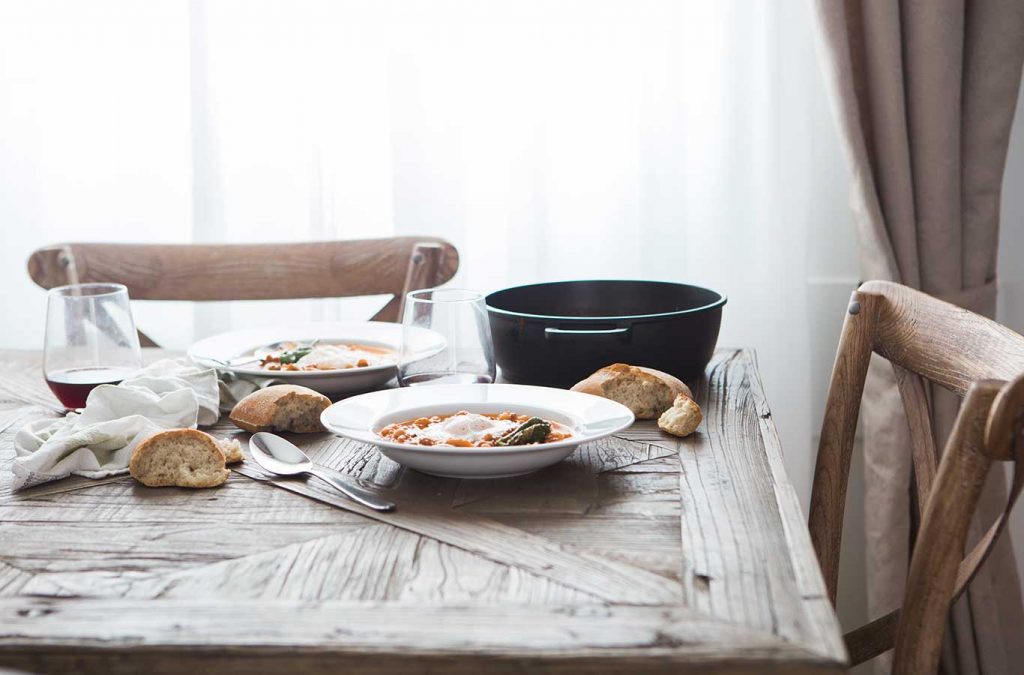In a world where we are constantly doing more and being less, we are all searching for real, tangible experiences to balance our lives. So much of this intention exists in every aspect of the work that we do at the bakery, as we constantly strive to balance the attention and care that we dedicate to our work with the attention and care that we dedicate to each other and to the culture, land, and community that define our sense of place. One tradition that stands out to me as a hallmark of this sense of balance is our weekly Friday staff lunch.
As bakers, we work long, hard hours, and Fridays are often the days when we labor the hardest and the longest. After nearly a decade or more of regularly pushing through twelve or more hours without a break, it occurred to me that the bakery crew ought to sit together and enjoy a meal in order to balance our longest day. Often our lunch hour encroaches on what would be considered dinnertime to most working folk, and sometimes the meal is a humble combination of odds and ends, but we all look forward to and cherish this time, a meal that marks the end of our daily shared effort, provides a space to celebrate our successes and troubleshoot our challenges and allows us the opportunity to enjoy both well-earned nourishment and intentional time together.
Some years ago, a dear friend handed me the most beautiful wild mushroom I’d ever seen. “Sweet, fat, sour, and spice,” he said. “That’s all you need to remember.” These four words summed up everything I’d ever need to know about cooking, and are even echoed in a recent best-selling cookbook by Samin Nosrat, entitled “Salt, Acid, Fat, Heat”. What both my friend Jim and Samin were trying to convey was the idea of balance; in order to have a well-rounded meal (or a well-rounded life, as it were), you need a little bit of everything and not too much of any one thing in particular.
It’s rare that I have time to read and measure while cooking on Fridays, so typically I don’t. The dishes you’ll read about here don’t come with traditional recipes; far from it in fact. I try to prepare them with a consideration for balance, for salt, acid, fat and heat, using what I have on hand or what inspires me about the day or the season. So much of cooking, like so much of building a life, isn’t about how closely you adhere to a prescribed set of instructions or a lengthy list of ingredients; rather it’s about using what you’ve got, following your intuition, adding a little bit of that and a lot of this, balancing textures and flavors, tasting as you go along. I hope these portraits of our weekly Friday lunch inspire you to close the book from time to time and simply cook by feel. You may be surprised by what you discover.
After a summer of homemade falafel, fish tacos, and garden tomato pie, we’re moving into soup and stew season. I call this “Stone Soup” because the story of stone soup evokes the essence of this kind of cooking.
Friday Lunch Stone Soup
Serve this with a crusty loaf of whole grain bread, cultured butter, and aged cheese.
Quantity suggestions are included in the description below.
- *Homemade bone broth (Farms often sell soup bones cheap, and every time you roast a chicken, you’ve got a pot of stock too.)
- *Allium: Onion, shallot, leek, garlic (Pick a couple or just one, and don’t be afraid to use the green part of the leek!)
- *Winter Squash (Buttercup, butternut, blue hubbard, and Kabocha are all great for soup)
- *Stew beef, ham hock or smoked sausage (Shanks of lamb or beef also work so long as the cooking time is long enough.)
- *Barley, farro or sorghum (best if cooked in advance)
- Carrot
- Potato
- Mushroom
- * Celery/fennel
- *Sweet corn
- Tomato
- *Red pepper, sweet & hot
- *Kale, collards or swiss chard
- *Fresh herbs. Basil, thyme, rosemary, oregano, parsley, savory, sage
- *Salt and pepper
Items with a * are “must haves” in my book, but swaps can certainly be made.
Directions for 1 pot of soup:
In a pot, you plan to fill with soup, sauté an inch or two layers of chopped alliums in butter or olive oil until translucent and starting to brown. Add starchy carbs and proteins until the pot is a little over two thirds full. Add enough stock to cover everything in the pot and bring to a boil. Add remaining ingredients until the pot is full while the soup simmers. Be generous with the quantities of greens and herbs. Fresh herbs add immeasurably to the soup’s quality and should be added in the final few minutes. Cook until squash is soft and mostly turned into thick broth. Improves with age.

